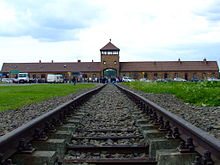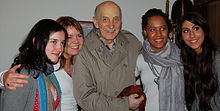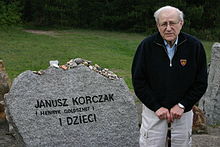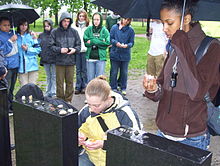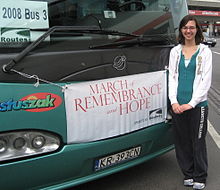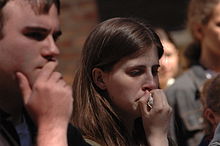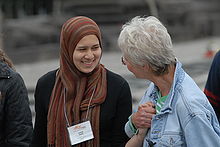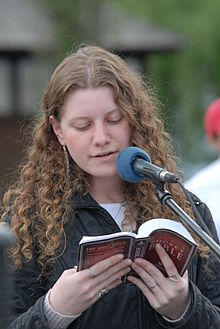- March of Remembrance and Hope
-
The March of Remembrance and Hope (MRH) is a program designed for university and college students of all religions and backgrounds. The program takes place in mid-May, and includes a two-day trip to Germany, followed by a five day visit to Poland. The international MRH program was founded in 2001 by Dr. David Machlis of the United States and Eli Rubenstein of Canada, both of whom were involved in the March of the Living program.
During the trip students visit locations in Germany and Poland related to the Holocaust and other World War II genocides, including the site of the Wannsee Conference, and the former concentration/death camps of Auschwitz, Treblinka and Majdanek.
The purpose of the March of Remembrance and Hope is to teach students of different religious and ethnic backgrounds about the dangers of intolerance through the study of the Holocaust and other World War II genocides, and to promote better relations among people of diverse cultures.
Holocaust survivors also participate in the March of Remembrance and Hope program sharing their painful memories in the very places in which their stories transpired. During the trip, the students also meet one of the Righteous Among the Nations, and learn of the heroic actions a minority of Europe's population took to resist Nazi tyranny.
Since its inception, students of many diverse religions, backgrounds and ethnicities have taken part in the March of Remembrance and Hope program, including: Christian, Buddhist, Muslim, Hindu, Jewish, Seventh Day Adventist and many others. In addition, students who come from their own history of persecution (such as survivors of the Rwandan Genocide, First Nation students, African Americans etc.) have also participated in the March of Remembrance and Hope.
Presently, the program is run annually in Canada for Canadian university students, by the Canadian Centre for Diversity along with the cooperation of other organizations.
The international MRH program is currently on hold, but there are American groups who have traveledl with the Canadian delegation, namely Nazareth College[disambiguation needed
 ] and Hobart and William Smith Colleges. There is also an Austrian program by the same name for university students of diverse backgrounds that travels to Poland earlier during the year, during the March of the Living (MOL). In 2010, Nazareth College[disambiguation needed
] and Hobart and William Smith Colleges. There is also an Austrian program by the same name for university students of diverse backgrounds that travels to Poland earlier during the year, during the March of the Living (MOL). In 2010, Nazareth College[disambiguation needed  ] and Hobart and William Smith Colleges launched their own program called The March: Bearing Witness to Hope - http://morah.naz.edu/.
] and Hobart and William Smith Colleges launched their own program called The March: Bearing Witness to Hope - http://morah.naz.edu/.(While there are similarities, MRH and MOL are two different programs. MRH is primarily aimed at university students of diverse backgrounds, does not include a trip to Israel, and its goals are of a universal nature. MOL is primarily aimed at Jewish high school students, and in addition to universal goals, also includes goals related to Jewish identity and connection to Israel, and usually includes a week long trip to Israel following the Poland portion of the trip.)
Two student organizations in Canada dedicated to teaching tolerance and combating genocide, "’Shout Canada "’ and "’Stand Canada "’, were founded by students who participated in Marches to Poland. Many of the student leaders and active members of these two organizations are alumni of the March of Remembrance and Hope program.
On January 27, 2007, International Holocaust Remembrance Day, Ms. Marie Mirlande Noel,[1] an African American student at the College of St. Elizabeth, and a graduate of the MRH program, addressed the United Nations about [2] her experience on the March of Remembrance and Hope program.
Goals of the March of Remembrance and Hope Program
- To never again allow for the unchecked rise of the menace of anti-Semitism or any kind of racial discrimination directed by any individual or group in society against another to gain strength. Included in this goal is the teaching that all human beings are equal, precious and valued, and the diminution of the dignity of any member of the human family is a cardinal violation of all ethical teachings.
- To recognize and learn from the altruistic actions of the "righteous among the nations", who teach us to never be a bystander in the face of oppression.
- To remember those who perished, to be a witness, thus denying Hitler a "posthumous victory". The role of the survivor is a key element in this goal.
- To pay tribute to the courage of those who survived the Holocaust, who rebuilt their lives despite the haunting memories of the past.
- To honor the heroic veterans of World War II who fought to liberate Europe from the hands of Nazi tyranny.
- To welcome opportunities to learn about participants' different ethnicities and beliefs so that we may transcend our religious, political, and cultural boundaries in order to bear witness to the common humanity we all share.
- To inspire participants to commit to building a world free of oppression and intolerance, a world of freedom, democracy and justice, for all members of the human family. Related to this goal is to teach the message that, when participants return to their communities, each of them has the ability to make a real and lasting difference in the world.
- The final goal is not so much to learn from or about history, but to enter into history. By visiting Germany and Poland, students are taking part in a commemorative act that declares that the memory of six million Jews and millions of other innocent victims - Poles, Roma and Sinti, Jehovah's Witnesses, homosexuals, the disabled and political prisoners - who were murdered during the Holocaust and World War II, has been marked and will never be forgotten.
Notes
- ^ Noelle, Marie Mirland (2007-01-27). "Marie Mirland Noel's Speech at the UN". United Nations. http://www.un.org/holocaustremembrance/2007/statements/noel.shtml. Retrieved 2007-01-27.
- ^ Staff, CSE (2007-02-09). "College of Saint Elizabeth Student Promotes Prejudice Reduction at the United Nations Annual Holocaust Day". College of St. Elizabeth Newsletter. http://www.cse.edu/blog/index.php/2007/02/09/college-of-saint-elizabeth-student-promotes-prejudice-reduction-at-the-united-nations-annual-holocaust-day/#more-99. Retrieved 20078-12-01.
External links
- Goals of the March of Remembrance and Hope
- March of Remembrance and Hope
- March of the Living International
- March of the Living Canada
- Students flock to Holocaust program in Europe
- Canadian nearly upstages the 'governator' at gala
- NMSU students to study the Holocaust in Poland
- The March of Remembrance and Hope
- Centre students travel to Holocaust sites with student leadership program
- The Effects of a Holocaust Education Experience on Preservice Teachers' Thinking About Diversity
- Speech by Sally Wasserman: Hidden Child & Holocaust Survivor, Auschwitz Birkenau, May 2, MRH 08
- Pinchas: A Holocaust Survivor, Majdanek, MRH 07
- Juliet Karugahe, a Rwandan Canadian, speaks on the importance of traveling to Poland on MRH
Categories:- Holocaust commemoration
- Auschwitz concentration camp
- Genocide education
- Youth pilgrimages
- Marches
Wikimedia Foundation. 2010.


